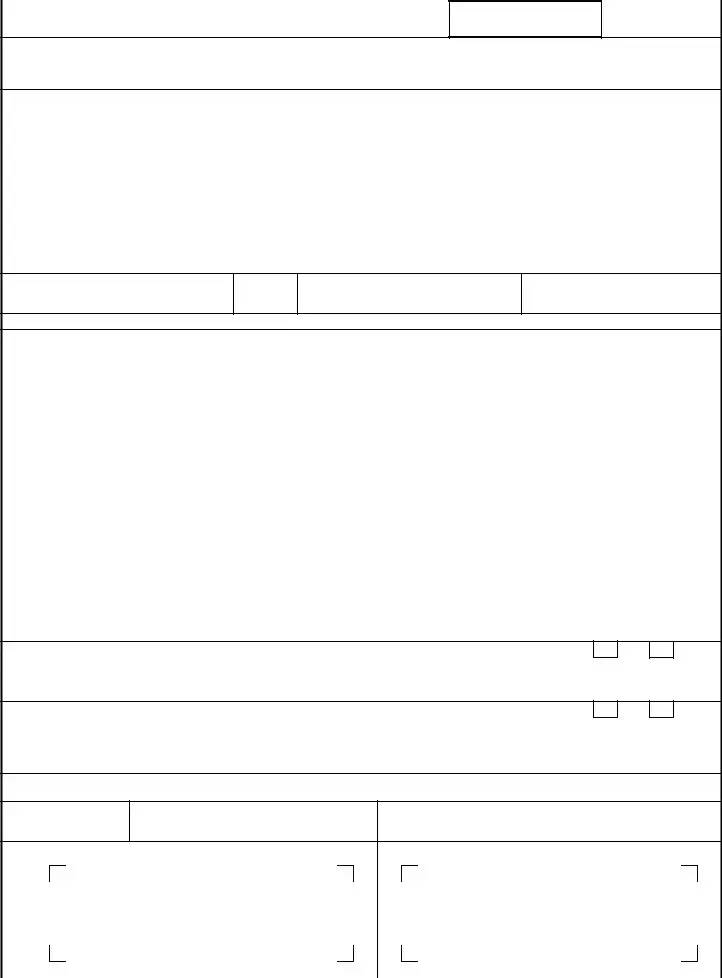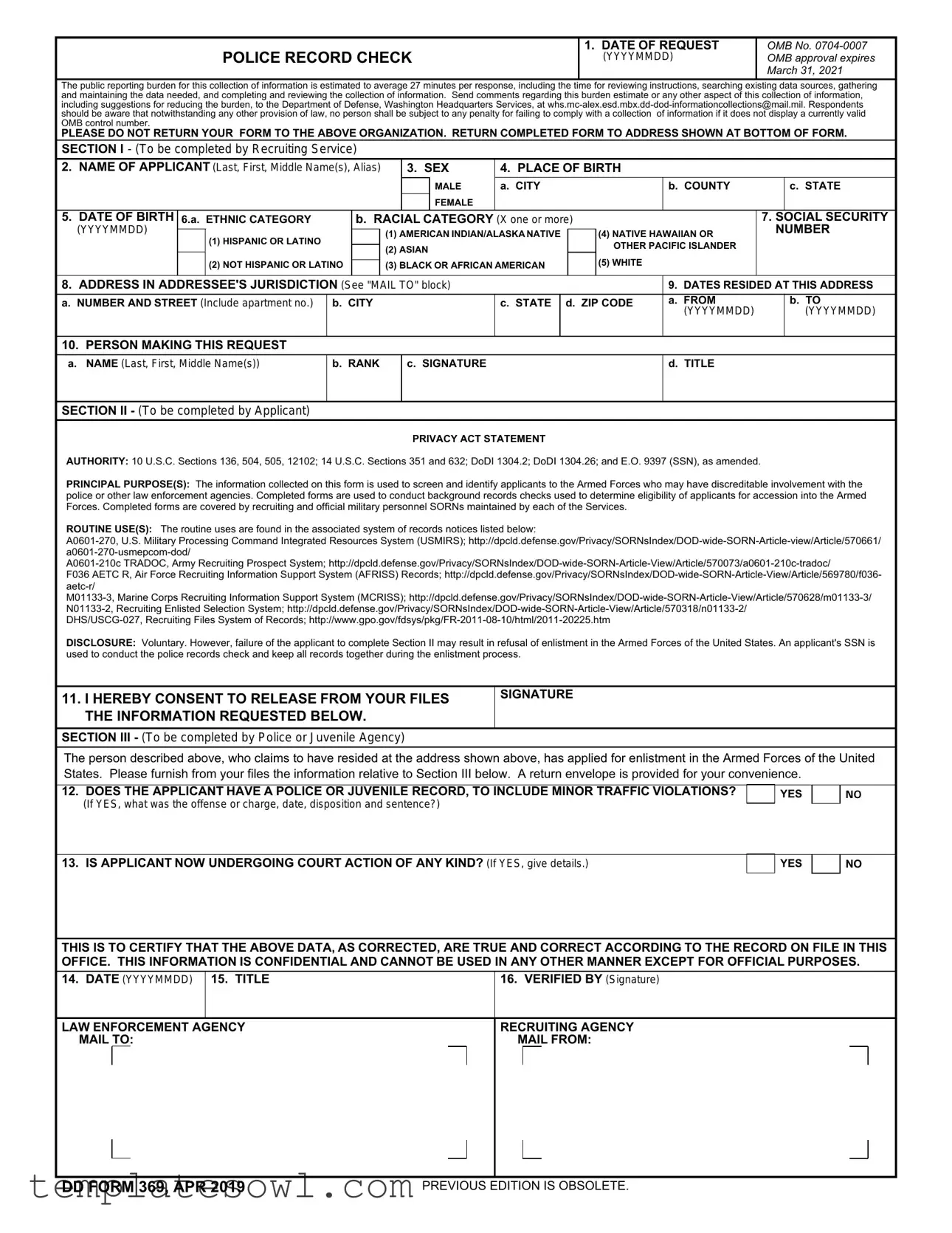
POLICE RECORD CHECK |
1. DATE OF REQUEST |
OMB No. 0704-0007 |
(YYYYMMDD) |
OMB approval expires |
|
|
March 31, 2021 |
The public reporting burden for this collection of information is estimated to average 27 minutes per response, including the time for reviewing instructions, searching existing data sources, gathering
and maintaining the data needed, and completing and reviewing the collection of information. Send comments regarding this burden estimate or any other aspect of this collection of information, including suggestions for reducing the burden, to the Department of Defense, Washington Headquarters Services, at whs.mc-alex.esd.mbx.dd-dod-informationcollections@mail.mil. Respondents should be aware that notwithstanding any other provision of law, no person shall be subject to any penalty for failing to comply with a collection of information if it does not display a currently valid OMB control number.
PLEASE DO NOT RETURN YOUR FORM TO THE ABOVE ORGANIZATION. RETURN COMPLETED FORM TO ADDRESS SHOWN AT BOTTOM OF FORM.
SECTION I - (To be completed by Recruiting Service)
2. |
NAME OF APPLICANT (Last, First, Middle Name(s), Alias) |
|
3. SEX |
4. PLACE OF BIRTH |
|
|
|
|
|
|
|
|
|
|
|
|
MALE |
a. CITY |
|
|
|
|
b. COUNTY |
|
c. STATE |
|
|
|
|
|
|
|
|
|
FEMALE |
|
|
|
|
|
|
|
|
|
5. |
DATE OF BIRTH |
6.a. ETHNIC CATEGORY |
|
b. RACIAL CATEGORY (X one or more) |
|
7. |
SOCIAL SECURITY |
|
(YYYYMMDD) |
|
|
|
|
|
(1) AMERICAN INDIAN/ALASKA NATIVE |
|
|
(4) NATIVE HAWAIIAN OR |
NUMBER |
|
|
(1) HISPANIC OR LATINO |
|
|
|
|
|
|
|
|
|
|
(2) ASIAN |
|
|
|
|
|
OTHER PACIFIC ISLANDER |
|
|
|
|
|
|
|
|
|
|
|
|
|
|
|
|
|
|
|
(2) NOT HISPANIC OR LATINO |
|
|
|
|
|
|
(5) WHITE |
|
|
|
|
|
|
|
|
(3) BLACK OR AFRICAN AMERICAN |
|
|
|
|
|
|
|
|
|
|
|
|
|
|
|
|
|
|
|
|
|
|
|
|
|
|
|
|
|
|
8. |
ADDRESS IN ADDRESSEE'S JURISDICTION (See "MAIL TO" block) |
|
|
|
|
|
|
9. DATES RESIDED AT THIS ADDRESS |
a. NUMBER AND STREET (Include apartment no.) |
b. CITY |
|
|
|
c. STATE |
|
d. ZIP CODE |
a. FROM |
|
b. TO |
|
|
|
|
|
|
|
|
|
|
|
|
|
|
|
|
(YYYYMMDD) |
|
(YYYYMMDD) |
|
|
|
|
|
|
|
|
|
|
|
|
|
|
|
|
|
|
|
10. PERSON MAKING THIS REQUEST
a.NAME (Last, First, Middle Name(s))
SECTION II - (To be completed by Applicant)
PRIVACY ACT STATEMENT
AUTHORITY: 10 U.S.C. Sections 136, 504, 505, 12102; 14 U.S.C. Sections 351 and 632; DoDI 1304.2; DoDI 1304.26; and E.O. 9397 (SSN), as amended.
PRINCIPAL PURPOSE(S): The information collected on this form is used to screen and identify applicants to the Armed Forces who may have discreditable involvement with the police or other law enforcement agencies. Completed forms are used to conduct background records checks used to determine eligibility of applicants for accession into the Armed Forces. Completed forms are covered by recruiting and official military personnel SORNs maintained by each of the Services.
ROUTINE USE(S): The routine uses are found in the associated system of records notices listed below:
A0601-270, U.S. Military Processing Command Integrated Resources System (USMIRS); http://dpcld.defense.gov/Privacy/SORNsIndex/DOD-wide-SORN-Article-view/Article/570661/ a0601-270-usmepcom-dod/
A0601-210c TRADOC, Army Recruiting Prospect System; http://dpcld.defense.gov/Privacy/SORNsIndex/DOD-wide-SORN-Article-View/Article/570073/a0601-210c-tradoc/
F036 AETC R, Air Force Recruiting Information Support System (AFRISS) Records; http://dpcld.defense.gov/Privacy/SORNsIndex/DOD-wide-SORN-Article-View/Article/569780/f036- aetc-r/
M01133-3, Marine Corps Recruiting Information Support System (MCRISS); http://dpcld.defense.gov/Privacy/SORNsIndex/DOD-wide-SORN-Article-View/Article/570628/m01133-3/ N01133-2, Recruiting Enlisted Selection System; http://dpcld.defense.gov/Privacy/SORNsIndex/DOD-wide-SORN-Article-View/Article/570318/n01133-2/
DHS/USCG-027, Recruiting Files System of Records; http://www.gpo.gov/fdsys/pkg/FR-2011-08-10/html/2011-20225.htm
DISCLOSURE: Voluntary. However, failure of the applicant to complete Section II may result in refusal of enlistment in the Armed Forces of the United States. An applicant's SSN is used to conduct the police records check and keep all records together during the enlistment process.
11. I HEREBY CONSENT TO RELEASE FROM YOUR FILES |
SIGNATURE |
THE INFORMATION REQUESTED BELOW. |
|
SECTION III - (To be completed by Police or Juvenile Agency) |
|
The person described above, who claims to have resided at the address shown above, has applied for enlistment in the Armed Forces of the United States. Please furnish from your files the information relative to Section III below. A return envelope is provided for your convenience.
12.DOES THE APPLICANT HAVE A POLICE OR JUVENILE RECORD, TO INCLUDE MINOR TRAFFIC VIOLATIONS?
(If YES, what was the offense or charge, date, disposition and sentence?)
13. IS APPLICANT NOW UNDERGOING COURT ACTION OF ANY KIND? (If YES, give details.)
THIS IS TO CERTIFY THAT THE ABOVE DATA, AS CORRECTED, ARE TRUE AND CORRECT ACCORDING TO THE RECORD ON FILE IN THIS OFFICE. THIS INFORMATION IS CONFIDENTIAL AND CANNOT BE USED IN ANY OTHER MANNER EXCEPT FOR OFFICIAL PURPOSES.
16.VERIFIED BY (Signature)
LAW ENFORCEMENT AGENCY MAIL TO:
RECRUITING AGENCY MAIL FROM:
DD FORM 369, APR 2019 |
PREVIOUS EDITION IS OBSOLETE. |

